1993 BUICK LESABRE check engine light
[x] Cancel search: check engine lightPage 195 of 324
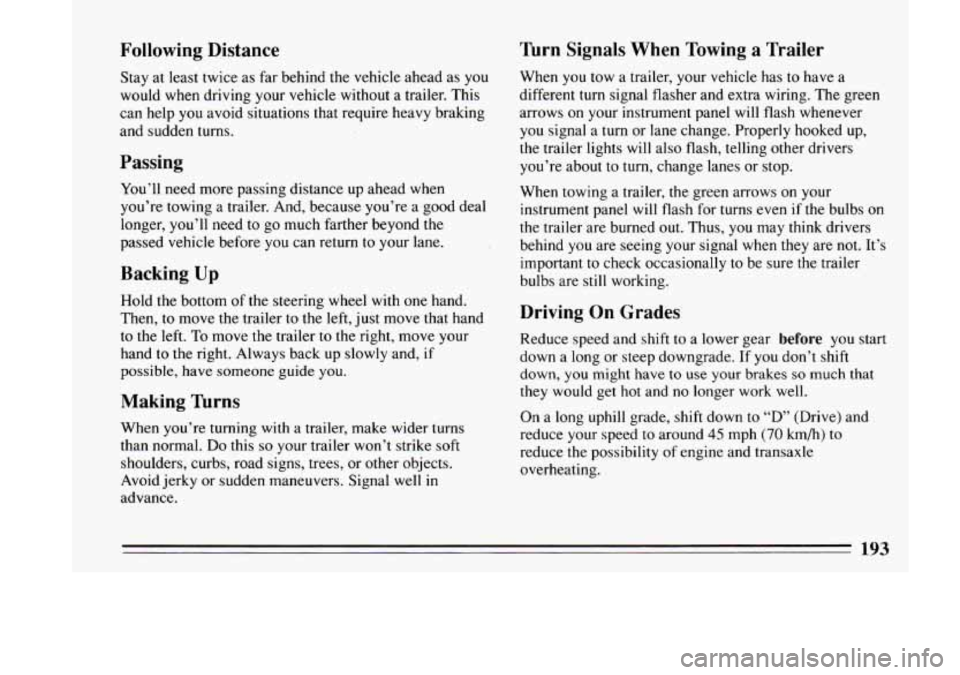
Following Distance
Stay at least twice as far behind the vehicle ahead as you
would when driving your vehicle without a trailer. This
can help
you avoid situations that require heavy braking
and sudden turns.
Passing
You’ll need more passing distance up ahead when
you’re towing a trailer. And, because you’re a good deal
longer, you’ll need to go much farther beyond the
passed vehicle before you can return
to your lane.
Backing Up
Hold the bottom of the steering wheel with one hand.
Then,
to move the trailer to the left, just move that hand
to the left. To move the trailer to the right, move your
hand
to the right. Always back up slowly and, if
possible, have someone guide you.
Making nrns
When you’re turning with a trailer, make wider turns
than normal. Do this
so your trailer won’t strike soft
shoulders, curbs, road signs, trees, or other objects.
Avoid jerky or sudden maneuvers. Signal well
in
advance.
Turn Signals When Towing a Trailer
When you tow a trailer, your vehicle has to have a
different turn signal flasher and extra wiring. The green
arrows
on your instrument panel will flash whenever
you signal a turn
or lane change. Properly hooked up,
the trailer lights will also flash, telling other drivers
you’re about to turn, change lanes or stop.
When towing a trailer, the green arrows on your
instrument panel will flash for turns even if the bulbs on
the trailer are burned out.
Thus, you may think drivers
behind you are seeing your signal when they are
not. It’s
important to check occasionally to be sure the trailer
bulbs are still working.
Driving On Grades
Reduce speed and shift to a lower gear before you start
down a long or steep downgrade. If you don’t shift
down,
you might have to use your brakes so much that
they would get hot and no longer work well.
On a long uphill grade, shift down to “D” (Drive) and
reduce your speed to around
45 mph (70 km/h) to
reduce the possibility of engine and transaxle
overheating.
193
Page 202 of 324
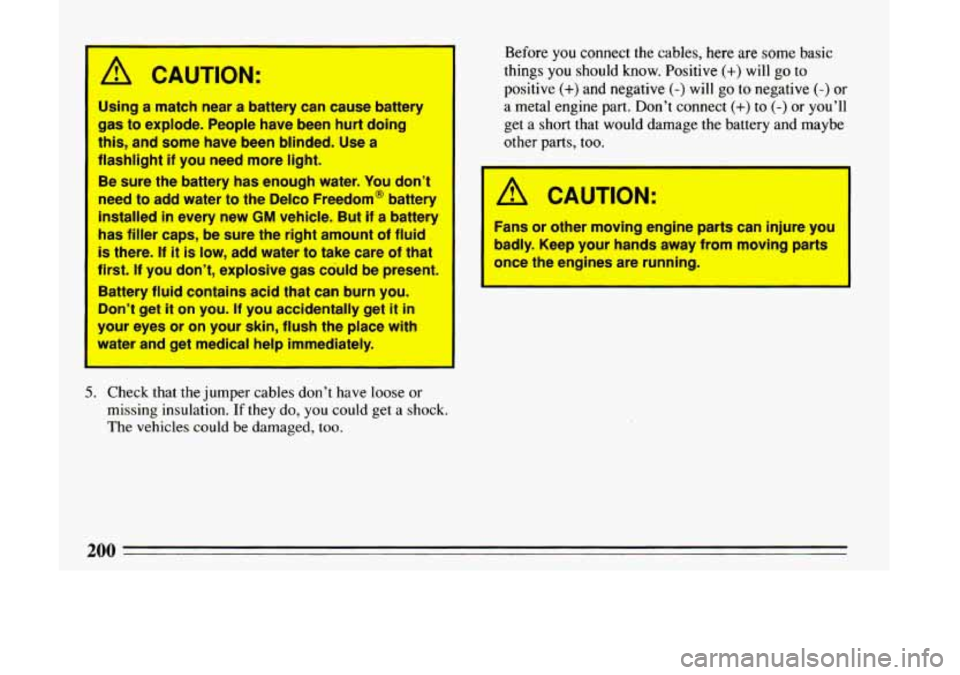
A CAUTION:
Using a match near a battery can cause battery
gas to explode. People have been hurt doing
this, and some have been blinded. Use a
flashlight
if you need more light.
Be sure the battery has enough water.
You don’t
need to add water to the Delco Freedom@ battery
installed in every new GM vehicle. But if a battery
has filler caps, be sure the right amount of fluid
is there. If it is low, add water to take care of that
first. If you don’t, explosive gas cduld be present.
Battery fluid contains acid that can burn you.
Don’t get it on you. If you accidentally get it in
your
eyes or on your skin, flush the place with
water and
get medical help immediately.
5. Check that the jumper cables don’t have loose or
missing insulation. If they do, you could get a shock.
The vehicles could
be damaged, too. Before
you connect the cables, here
are some basic
things
you should know. Positive (+) will go to
positive
(+) and negative (-) will go to negative (-) or
a metal engine part. Don’t connect
(+) to (-) or you’ll
get a short that would damage
the battery and maybe
other parts, too.
A CAUTION:
. ms or other moving engine parts can injure you
badly.
Keep your hands away from moving parts
once the engines
are running. I I I
200
Page 245 of 324
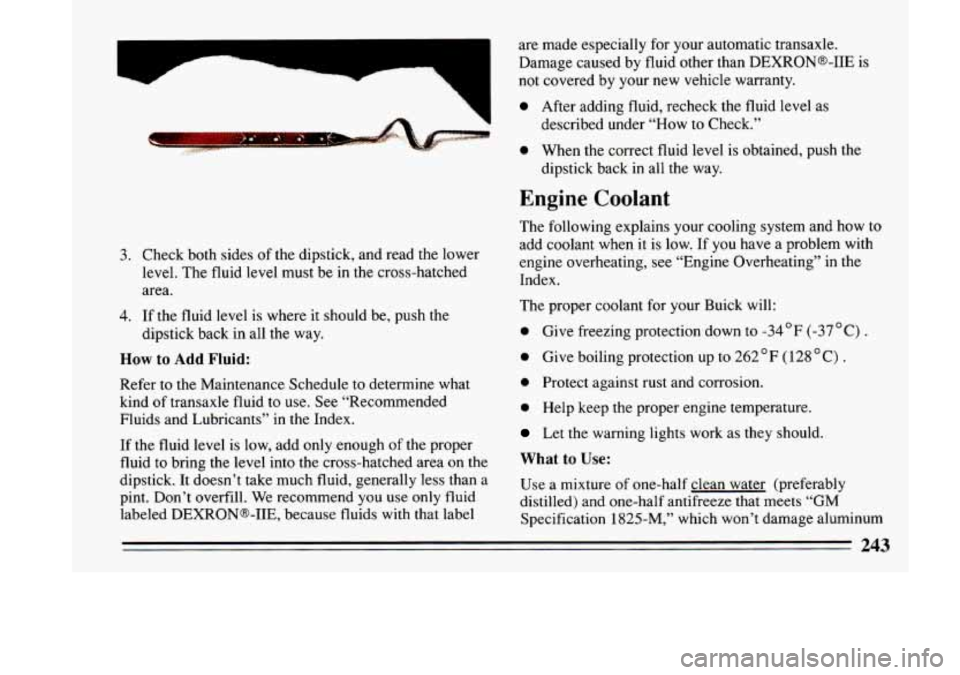
3.
4.
Check both sides of the dipstick, and read the lower
level. The fluid level must be in the cross-hatched
area.
If the fluid level is where it should be, push the
dipstick back in all the way.
How to Add Fluid:
Refer to the Maintenance Schedule to determine what
kind
of transaxle fluid to use. See “Recommended
Fluids and Lubricants” in the Index.
If the fluid level
is low, add only enough of the proper
fluid to bring the level into the cross-hatched area on the
dipstick. It doesn’t take much fluid, generally less than a
pint. Don’t overfill. We recommend you use only fluid
labeled DEXRONa-IIE, because fluids with that label are made especially for your automatic transaxle.
Damage caused by fluid other than DEXRONs-IIE
is
not covered by your new vehicle warranty.
0 After adding fluid, recheck the fluid level as
described under “How to Check.”
0 When the correct fluid level is obtained, push the
dipstick back in all the way.
Engine Coolant
The following explains your cooling system and how to
add coolant when it is low. If you have a problem with
engine overheating, see “Engine Overheating” in the
Index.
The proper coolant for your Buick will:
0 Give freezing protection down to -34OF (-37OC) .
0 Give boiling protection up to 262°F (128 “C) .
0 Protect against rust and corrosion.
0 Help keep the proper engine temperature.
Let the warning lights work as they should.
What to Use:
Use a mixture of one-half clean water (preferably
distilled) and one-half antifreeze that meets
“GM
Specification 1825-M,” which won’t damage aluminum
243
Page 295 of 324
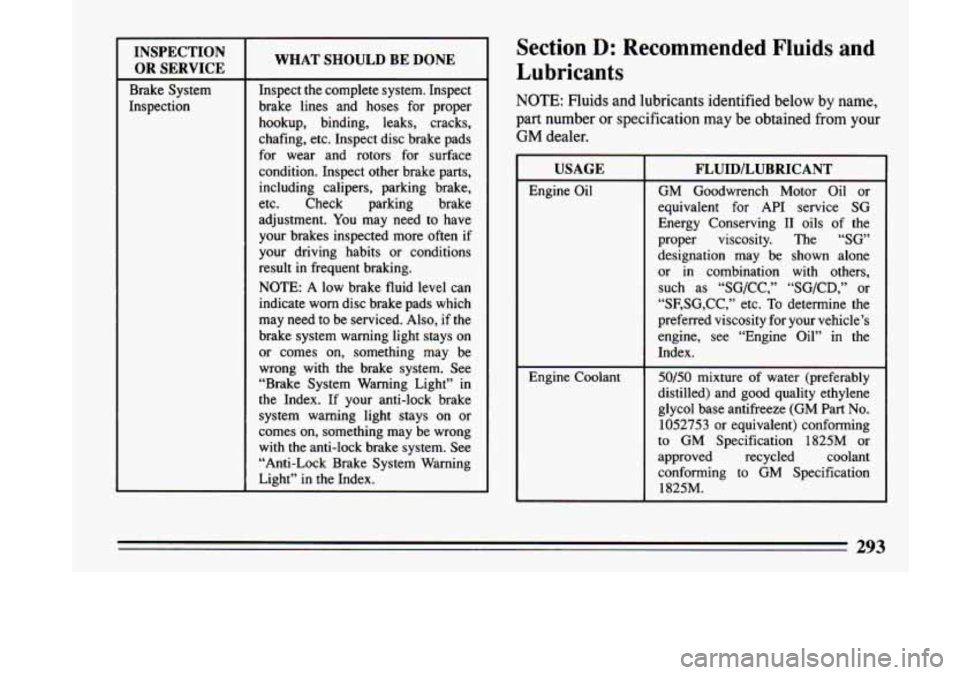
INSPECTION OR SERVICE
Brake System
Inspection
WHAT SHOULD BE DONE
Inspect the complete system. Inspect
brake lines and hoses for proper hookup, binding, leaks, cracks,
chafing, etc. Inspect disc brake pads
for wear and rotors for surface
condition. Inspect other brake parts, including calipers, parking brake,
etc. Check parking brake
adjustment.
You may need to have
your brakes inspected more often
if
your driving habits or conditions
result in frequent braking.
NOTE:
A low brake fluid level can
indicate worn disc brake pads which
may need to be serviced. Also,
if the
brake system warning light stays on
or comes on, something may be
wrong with the brake system. See
“Brake System Warning Light” in
the Index. If your anti-lock brake
system warning light stays
on or
comes on, something may be wrong
with the anti-lock brake system. See
“Anti-Lock Brake System Warning
Light” in the Index.
Section D: Recommended Fluids and
Lubricants
NOTE: Fluids and lubricants identified below by name,
part number
or specification may be obtained from your
GM dealer.
FLUID/LUBRICANT
GM Goodwrench Motor Oil or
equivalent for API service SG
Energy Conserving I1 oils of the
proper viscosity. The
“SG’
designation may be shown alone
or
in combination with others,
such as “SG/CC,” “SG/CD,” or
“SF,SG,CC,” etc.
To determine the
preferred viscosity for your vehicle’s
engine, see “Engine Oil’’ in the
Index.
50/50 mixture of water (preferably
distilled) and good quality ethylene
glycol base antifreeze (GM Part
No.
1052753 or equivalent) conforming
to GM Specification 1825M or
approved recycled coolant
conforming to GM Specification
1825M.
293
-
Page 308 of 324

Brake Adjustment
................................... 163
Fluid 248 .......................................
Lining Replacement. How to Drive After .......... 249
Master Cylinder
.............................. 248
Brake-Transaxle Shift Interlock
................... 73. 80
Brake System. Antilock Warning Light ............... 108
Brake System Warning Light
....................... 107
Brake Wear Indicators. Disc
....................... 162
Brakes. Antilock
................................ 160
Braking Emergencies
............................. 163
Braking if Your Engine Stops
...................... 160
Break-In. New Vehicle
............................. 68
Break-In Schedule. When Towing a Trailer
............ 189
Bulb Replacement. Headlamp
...................... 250
Bulb Replacement Taillamp
........................ 252
Bulbs. Halogen
.................................. 250
Bulbs.
Turn Signal ................................ 85
Parking ...................................... 76
PedalTravel
................................. 163
Brakes,Rear
.................................... 163
Braking 158 ........................................
Bulbchart ..................................... 274
Camper. Towing a
.............................. 189
...................................... Capacities 275
Cap. Radiator Pressure 245
Care,Appearance
................................ 262
I ............................ Carbon Monoxide in Exhaust ....................... 81
Cassette Tape Player Care
......................... 141
Cautions, Safety
.................................. 10
CB Radio, Adding a
.............................. 128
I
Cellular Telephone. Adding a ...................... 128
“Change Oil Soon” Light
.......................... 114
Change Oil. When to
............................. *239
Changing a Flat Tire
.............................. 216
Charge.Battery.. Warning Light
..................... 115 .
“Check Oil Level” Light .......................... 113
Engine Coolant
............................... 243
Engine Oil Level
.............................. 236
Power Steering Fluid
.......................... 246
Safety Belt Systems
............................ 55
Transaxle Fluid ............................... 241
Windshield Washer Fluid
.......................... 247
Chemical Paint Spotting
........................... 367
Children and Safety Belts
.......................... 41
Cleaner. Air
............... .................... 240
Aluminum Wheels
............................ 266
Inside Your Car
................................ 262
Outside Your Car
............................. 265
Top of the Instrument Panel ..................... 264
Underbody
of Your Car ........................ 267
Vinyl
or Leather .............................. 264
..................................... Chains. Tie 261
Checking BrakeFluid
.................................. 248
UndertheHood
................................. 234
.................................. Child Restraints 43
Cigarette Lighter
................................ 103
CircuitBreakers
................................. 270
City Driving 175
Cleaning ....................................
Fabric ...................................... 263
Glass
...................................... 265
PowerAntenna
............................... 142
Safety Belts 265 ..................................
Page 313 of 324
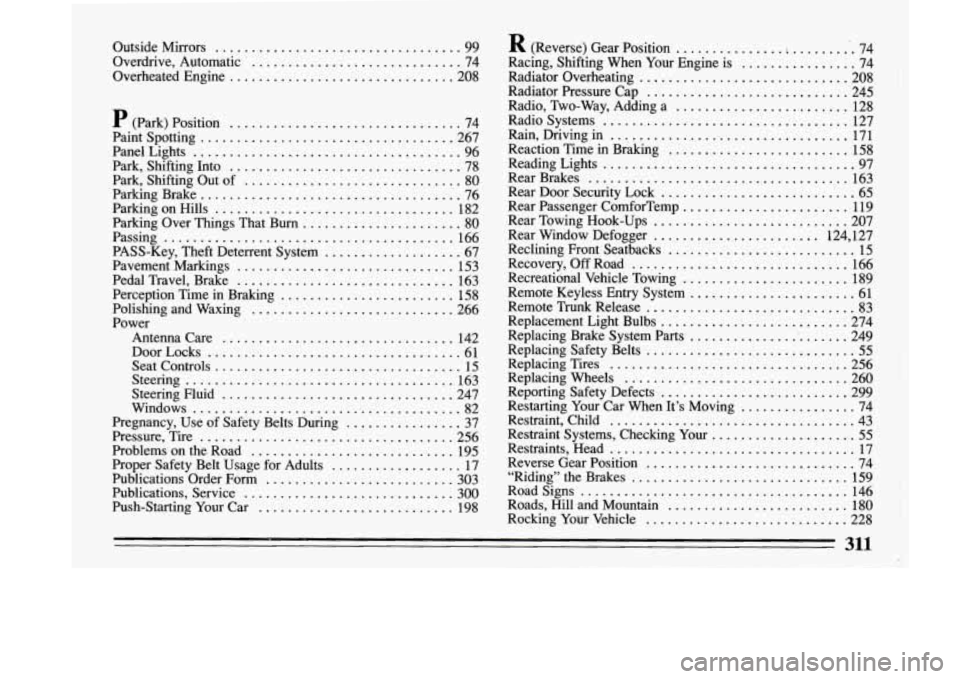
Outside Mirrors .................................. 99
Overdrive. Automatic
............................. 74
Overheated Engine
............................... 208
P (park) Position ................................ 74
PaintSpoaing
................................... 267
Park Shifting Into
................................ 78
Park, Shifting Out of
.............................. 80
Parking Brake .................................... 76
Parking on Hills
................................. 182
Parking Over Things That Burn
...................... 80
PASS-Key, Theft Deterrent System ................... 67
Pavement Markings
.............................. 153
PedalTravel, Brake
.............................. 163
Perception Time in Braking
........................ 158
Polishing and Waxing
............................ 266
Power
Antennacare
................................ 142
Seat Controls
.................................. 15
PanelLights
..................................... 96
passing
........................................ 166
Door Locks
................................... 61
Steering
..................................... 163
Whdows
..................................... 82
Pressure, Tire
................................... 256
Steering Fluid
................................ 247
Pregnancy, Use of Safety Belts During
................ 37
Problems on the Road
............................ 195
proper Safety Belt Usage for Adults
.................. 17
Publications Order Form
.......................... 303
Publications, Service
............................. 300
Push-Starting Your Car
........................... 198
R (Reverse) Gear Position ............... : .......... 74
Racing. Shifting When Your Engine is
................ 74
Radiator Overheating
............................. 208
Radiator Pressure Cap
............................ 245
Radio. Two-way. Adding a
........................ 128
Radio Systems
................................... 127
Rain. Driving in
................................. 171
Reaction Time in Braking
......................... 158
Reading Lights
................................... 97
Rear Door Security Lock
........................... 65
Rear Passenger ComforTemp
....................... 119
Rear Towing Hook-Ups
........................... 207
Rear Window Defogger
....................... 124, 127
Reclining Front Seatbacks
.......................... 15
Recovery,
Off Road .............................. 166
Recreational Vehicle Towing
....................... 189
Remote Keyless Entry System
....................... 61
Remote Trunk Release
............................. 83
Replacement Light Bulbs
.......................... 274
Replacing Safety Belts
............................. 55
Replacing Tires ................................. 256
Replacing Wheels ............................... 260
Reporting Safety Defects
.......................... 299
Restarting Your Car When It’s Moving
................ 74
Restraint, Child
.................................. 43
Restraint Systems, Checking Your
.................... 55
Reverse Gear Position ............................. 74
“Riding” the Brakes
.............................. 159
Road Signs 146
Roads, Hill and Mountain
......................... 180
Rocking Your Vehicle
............................ 228
RearBrakes
.................................... 163
Replacing Brake System Parts
....................... 249
Restraints, Head
.................................. 17
.....................................
311